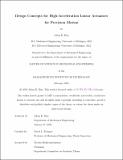Design Concepts for High-Acceleration Linear Actuators for Precision Motion
Author(s)
Kim, Adam K.
DownloadThesis PDF (28.57Mb)
Advisor
Trumper, David L.
Terms of use
Metadata
Show full item recordAbstract
Advances in semiconductor photolithography scanners have made it possible to produce smaller, more affordable chips with higher throughput. Some of the key lithographic scanner components supporting these advancements are electromagnetic actuators responsible for positioning the long-stroke (LS) and short-stroke (SS) stages of the reticle stage in its scan direction. Such actuators need to provide the highest thrust at the deceleration and reacceleration phases when the stages turn around at the ends of the scanning trajectory. Thus, enhancing their acceleration capability and force output is essential for boosting chip throughput. However, the improved performance may demand large current densities that are unsustainable in terms of the associated power dissipation generated by ohmic losses in the copper coils. In this thesis, we continued a previous study conducted in our lab that explored the use of mechanical contact forces managed by a piezoelectric stack actuator (PEA). In this configuration, intermittent contact by the PEA can be used to apply forces to decelerate and reaccelerate the SS stage with respect to the LS stage during turnaround events. With such force assist, the non-contact precision actuators responsible for positioning the SS stage with respect to the LS stage no longer need to generate large thrusts for the deceleration and reacceleration. As a result, we can in principle decrease the weight and power loss of the SS-stage precision actuators, which thus lowers the thrust requirements for the LS-stageAdvances in semiconductor photolithography scanners have made it possible to produce smaller, more affordable chips with higher throughput. Some of the key lithographic scanner components supporting these advancements are electromagnetic actuators responsible for positioning the long-stroke (LS) and short-stroke (SS) stages of the reticle stage in its scan direction. Such actuators need to provide the highest thrust at the deceleration and reacceleration phases when the stages turn around at the ends of the scanning trajectory. Thus, enhancing their acceleration capability and force output is essential for boosting chip throughput. However, the improved performance may demand large current densities that are unsustainable in terms of the associated power dissipation generated by ohmic losses in the copper coils. In this thesis, we continued a previous study conducted in our lab that explored the use of mechanical contact forces managed by a piezoelectric stack actuator (PEA). In this configuration, intermittent contact by the PEA can be used to apply forces to decelerate and reaccelerate the SS stage with respect to the LS stage during turnaround events. With such force assist, the non-contact precision actuators responsible for positioning the SS stage with respect to the LS stage no longer need to generate large thrusts for the deceleration and reacceleration. As a result, we can in principle decrease the weight and power loss of the SS-stage precision actuators, which thus lowers the thrust requirements for the LS-stage actuators responsible for accelerating both the LS and SS stages, resulting in lowered power consumption. Using the single degree-of-freedom experimental setup previously built in our lab, we conducted several characterization experiments to develop a PEA position feedback controller augmented by a hysteresis-compensated feedforward trajectory to shape the contact compression and forces. We find that introducing a viscoelastic contact interface is essential for stabilizing the PEA controller and slowing the contact dynamics to remain within the controller bandwidth. Our feedforward trajectory successfully brings a 0.84 kg mass moving towards the PEA with an initial speed of 60 mm/s to zero velocity in approximately 1.5 ms using 36 µm of PEA stroke length. These results demonstrate the feasibility of using PEAs as mechanical assist devices for high-acceleration turnaround events in lithography tools.
Date issued
2025-02Department
Massachusetts Institute of Technology. Department of Mechanical EngineeringPublisher
Massachusetts Institute of Technology